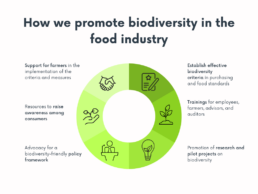What we do
Food for Biodiversity places the promotion, restoration and conservation of biodiversity at the center of its work. Food producers and traders, standards and other industry players, scientific institutions and environmental organizations pull together as members: they commit to implementing measures that anchor the protection of biodiversity in the food industry and its upstream value chains.
Commitment
Standard setters and companies that produce, process, trade and certify food, as well as organizations with an interest in promoting the protection of biodiversity in the food sector, can become members of Food for Biodiversity. Members support the objectives of the association and contribute to their achievement by, within their possibilities
- Anchoring the protection and promotion of biodiversity in their strategies, policies and projects and provide information on their measures.
- Implement criteria for the protection and promotion of biodiversity (basic set) along the supply chain in purchasing and standard specifications and support farmers in the implementation of the criteria and corresponding measures through attractive incentives. Representatives from agriculture, NGOs and scientific institutions promote implementation through advice, information, studies and projects.
- Implement monitoring of the development of biodiversity on farms and make the results available within the legal framework to evaluate the situation and further develop measures to promote biodiversity.
- Carry out awareness-raising measures and further training on biodiversity for employees, farmers, agricultural advisors and auditors, or support the dissemination of training courses and their further development.
- Be actively involved in the development and implementation of research and pilot projects to promote biodiversity in the food sector.
- Raise awareness among consumers in Germany about the value of biodiversity for food production and promote the supply and demand of corresponding products.
- Advocate that political framework conditions at national and European level (e.g. Common Agricultural Policy of the EU) have a positive effect on the protection of biodiversity and that agricultural producers receive attractive incentives to make their contribution to the protection of biodiversity.
- Also engage in improved biodiversity protection in countries outside Europe, from which important agricultural products are sourced, and exchange on their experiences.
Added value
Full members and sustaining members support the goals of the Food for Biodiversity Association by implementing concrete measures within their means.

Pilot Projects
The association members (food producers, traders, standards and certification companies, suppliers, producer organisations, farms) undertake to implement the biodiversity criteria of the current and relevant basic set for biodiversity-relevant raw materials. The association adopts the framework conditions for the consideration (roll-out) of the basic set (including general objectives and steps, timetable, monitoring).
Within this framework, the members define their individual roadmap for the roll-out of the basic set. New members complete a pilot project within the first two years to gain experience with the basic set. This pilot project should take place with several producers in a supply chain. An existing activity can also be “scaled up”. Co-operation between the members is desired. The pilot project will be documented in accordance with the organisation’s specifications.
In addition, all members are motivated to realise initiatives for the implementation of tools, training courses and other offers of the association.
With regard to the identification of biodiversity-relevant focus commodities, an approach is favoured that particularly takes into account the importance for the company (e.g. volume) and the relevance for biodiversity. Relevance includes the protection of existing biodiversity as well as the creation of potential for biodiversity in agriculture in Germany, Europe and at the international level. Existing databases, studies, hotspot analyses by companies and expert knowledge can be used to assess risks and opportunities.
Agricultural commodities
Agricultural commodities are raw materials that occur naturally as unprocessed agricultural products. They can basically be divided into the following groups:
- Food and feed: cereals e.g. barley, oats, maize, rice, rye, soybean meal, triticale, wheat
- Luxury food: coffee, cocoa, tobacco, tea
- Root crops and vegetables: e.g. potatoes, cassava, field vegetables, sugar cane and sugar beet
- Fruit: Fruit types such as soft fruits, pome fruits, nuts, stone fruits, classic tropical fruits and tropical fruits
- Oil plants: especially avocado, hemp, flax, oil palm, rapeseed, sesame and soy
- Animal products: Meat, fish and seafood, aquaculture products, milk, eggs, honey,…
- Technical agricultural commodities: cotton, rubber or wool.
After further processing by agricultural production, all species become agricultural products that serve either as food, animal feed or biomass. In Germany, 60 per cent of agricultural land is used for food production and about 26 per cent for animal feed. Some authors also include industrial agricultural raw materials such as timber and pulp.
We have set ourselves the task of increasing biodiversity performance in the food sector. Therefore, the following agricultural commodities listed above for the sake of completeness are omitted: tobacco, cotton, rubber, wool, timber and pulp.
